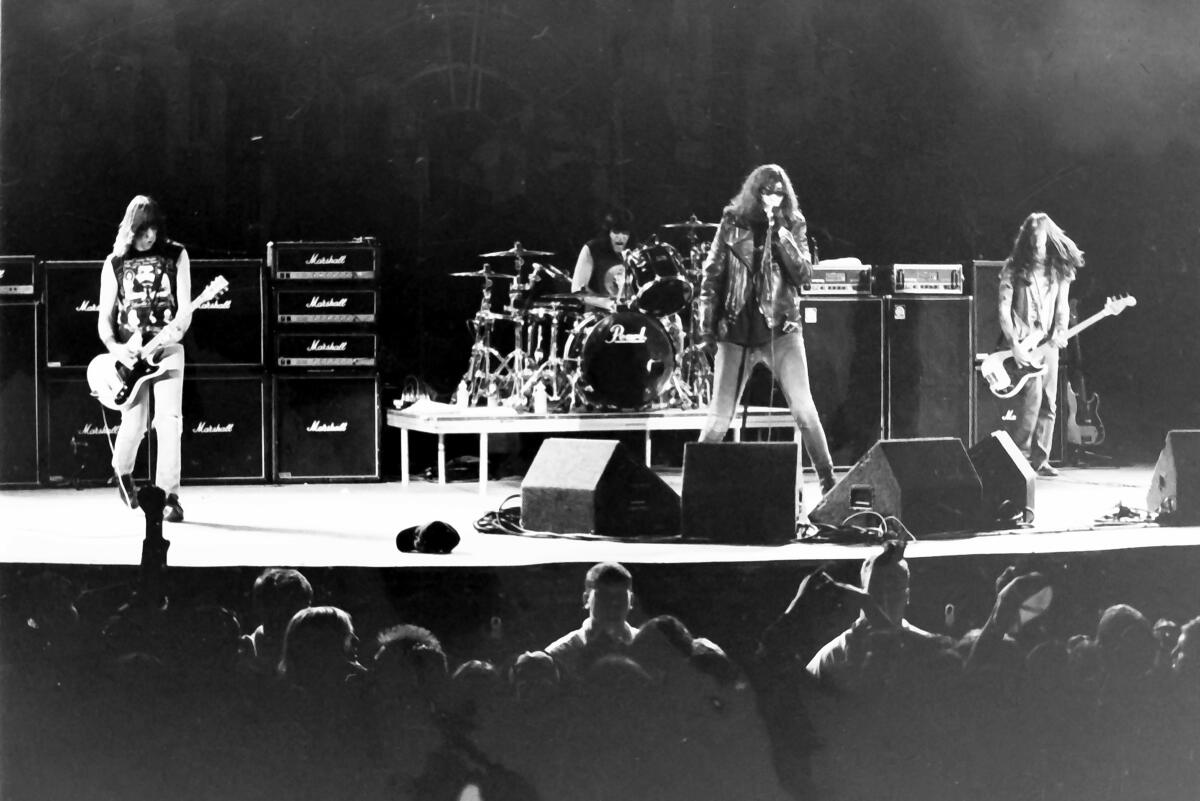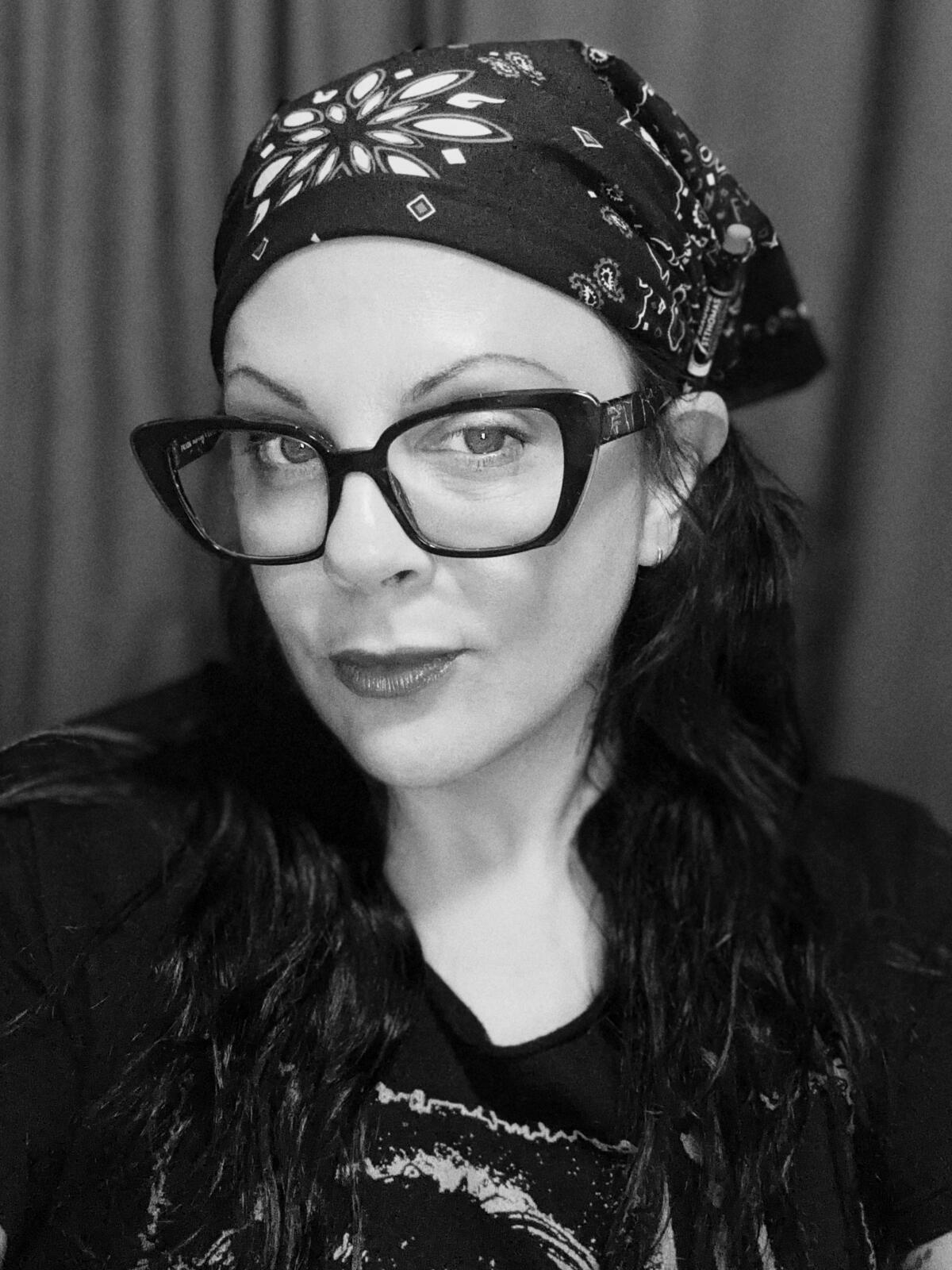On the Shelf
Subject: Punk
By Maggie St. Thomas, $49
If you buy books linked on our site, The Times may earn a commission from Bookshop.org, whose fees support independent bookstores.
Maggie St. Thomas had an unusual childhood that led to a lifetime of documenting rare moments in punk rock history.
As a 6-year-old, St. Thomas used to go out on school nights and hang out at seedy music venues with her dad to watch bands like Motörhead and TSOL. In 1991, when she was in sixth grade, she casually picked up a camera to shoot a political rally at Los Angeles City Hall, where L7 and Red Hot Chili Peppers were performing. St. Thomas says this is the moment she discovered her passion for photography, and over the next few decades, her life became consumed by punk rock shows and film rolls.
The SoCal native went on to shoot revered acts like the Ramones, Johnny Thunders, and Lemmy Kilmister of Motörhead, capturing many private moments with musicians off stage too. St. Thomas has compiled these and countless more images in her latest book, “Subject: Punk,” a collection and chronicle of her punk rock photography from the ‘90s to the present. The book, which published its second edition in October, also includes music journalism narratives and past interviews that the punk rock photographer conducted with musicians like Wayne Kramer of MC5, Markie and Johnny Ramone of the Ramones, and many others.
This interview has been edited for length and clarity.

The Ramones at the KROQ Weenie Roast in Irvine in 1995.
(Maggie St. Thomas)
Your latest book, “Subject: Punk,” captures your photography in the SoCal punk scene from the ‘90s to present day. Despite all the great bands you were capturing in the early ‘90s, your dream was to ultimately shoot the Ramones. What did that moment mean to you when it finally happened?
When it finally happened, it was June 17, 1995. I’ll never forget that day. I still have the T-shirt that they signed, I haven’t washed it, and I’ve only worn it on a couple special occasions since. It was everything to me — seeing the Ramones at a very early age, watching “Rock ‘n’ Roll High School” on TV. I remember my dad saying, “Make sure you’re in before the streetlights come on because ‘Rock ‘n’ Roll High School’ is going to be on.” I had no idea what to expect, I remember watching it and I was just like, “Oh, my gosh, these guys are incredible,” so it was everything to me, absolutely. When I photographed the Ramones, Rage Against the Machine, Hole, White Zombie and Sublime were on the same bill. It was huge. During the Ramones’ set, I thought, “OK, I can die happy now, I did what I wanted to do in life.” I chose to look at it like a calling and pursue it. I’m so thankful I’m still here — I’ve lived so many lives since 1995.
You eventually became close to Arturo Vega, the Mexican graphic designer and artist who created the Ramones’ iconic logo and who is known by fans as “the fifth Ramone.” What was your relationship like, and how did he support your work?
Arturo Vega was incredible, so supportive, and he did so much. He helped me get this one interview with Johnny Ramone. Johnny didn’t talk to many people, he was a man of few words, and the fact I got an interview, I was just like, “Whoa.” Arturo did so much, and I remember he would say, ‘You gotta put a book out,’ and this was early on. I got a quote from him in 2001 about my work with the Ramones, he said some amazing words, I still have the email that he wrote, and he was always great. When I was in New York in his loft photographing him, CJ Ramone came in while Arturo was showing Ramones artwork to me and sharing different stories that happened, for example, he would point at the floor and say, “Over there — that’s the stain where Dee Dee burned it with candles.” He was a wealth of so much history and I really, really admired him. He saw them as more than just a band; they were an art, a work of art. I mean, thank God for Arturo Vega.

A crowd surfer at the now-closed Showcase Theatre in Corona 1996.
(Maggie St. Thomas)
Your book describes how interesting your childhood was. While other kids were having bedtime stories read to them at night, you were at music venues with your dad watching acts like Motörhead, Johnny Thunders and TSOL. How instrumental was your dad in cultivating your passion for music and sparking your work as a photographer?
Extremely. I went everywhere with him, and it was a different childhood, I’ll say that. And the thing is, when you’re a kid and you are brought up a certain way, I figured everybody did that until I realized they didn’t. It was a very different life from what most kids were living. I remember when I saw Lemmy Kilmister in 2006, while we were doing a portrait that would be featured in the book. I shared with him that I saw Motörhead in concert when I was 6 years old. Lemmy gave me a thumbs up and said, “That’s true rock ‘n’ roll.”
The day that everything clicked — it happened at a very early age, and I’m so thankful for that. Sixth grade, I ditched school that day and I went with my dad. He was going to document some L.A. show; that’s all I knew. I just didn’t want to go to school and I went with him in his 1984 El Camino, and we went to L.A. City Hall for a rally. The Red Hot Chili Peppers played, L7 played, I was right up front, you couldn’t get any closer, and I had an 8-millimeter camera. My dad was filming, documenting the event, and I was just a sixth-grader, bright-eyed like, wow. That was such an incredible moment, looking behind me and seeing thousands of people and then there I am. How can school compare with that?
After this big moment, this realization that this was your calling, who were some of the first bands that you started shooting?
Well, shortly after in 1992, I photographed Dr. Timothy Leary with my dad at Chapman University, and then in 1993 I started shooting at the Hong Kong Cafe [in L.A.] these anarchy, crustcore punk bands. Other bands I was shooting at Hong Kong Cafe included MDC and Total Chaos.

Maggie St. Thomas
(Courtesy of Maggie St. Thomas)
What was it like for you as a woman shooting bands in the ‘90s, when concert photography was much more male-dominated than it is today?
It still is very much well-dominated by men today. It’s a man’s world no matter how you slice it, and being a woman in the field — I’m sure as you can relate — there are challenges. It was difficult then and it still is difficult in some ways. In my experiences, I’ve found that women oftentimes have to work harder than men to be taken seriously, not just in photography, but in any profession.
What advice do you have for other women who want to get into this and navigate this environment to do concert photography?
You’ve got to have thick skin, you’ve got to really be determined, and you’ve got to believe in yourself. I didn’t have prestigious schools behind me. When I got into this, I was learning as I went, and this was the time of film, which is much more unforgiving than digital. I have so many rolls of film where there’s stills of blurs and under exposures, and overexposed pictures, but I kept on shooting. You’ve got to really believe in yourself, even if it’s only you, because it’s great when you have an audience and the support of people applauding you telling you how great you are, but that isn’t always there, and that isn’t how you grow. So, you’ve got to really believe in yourself and always keep moving forward.

X performs at Pacific Amphitheatre in 2024.
(Maggie St. Thomas)
“Subject: Punk” chronicles the evolution of the SoCal punk scene through the decades, but how is this book more than just a collection of photos, and what does it represent to you?
To me it represents heart and soul. This book wasn’t easy to put together at all. I had a lot going against me, but I also had a lot of support from some pretty amazing people. The artists who are featured on the cover are artists who absolutely supported me through this: Exene Cervenka of X, Lou Koller of Sick of It All, Corey Parks, she played with Die’ Hunns and Nashville Pussy, Gina Volpe of the Lunachicks, and, of course, the spirit of the greatest band ever, the Ramones. I put everything into this book — it is heart, it is soul, it is tears, it is sweat. “Subject: Punk” is no bulls—, man.
What’s your favorite photograph in the book?
Every photograph I’ve captured of the Ramones will always be my favorite, but there are so many others. I look at the photographs on the pages, some of which were taken three decades ago. That’s part of my youth, what I did growing up, and I’m still alive, I’m still here. There’s a lot of people in this book that aren’t [alive anymore], and that is something I never take for granted, to be alive, and to experience and see some of the fruits of my labor. I am so incredibly grateful to be talking to you right now — that’s the greatest gift. I look at this book like, “Wow, I did it. I actually put this book together.” That quote from Arturo Vega from more than two decades ago is right where it’s meant to be — in the book he always told me I should put out — so here it is.

“Subject: Punk” book cover
(Courtesy of Maggie St. Thomas)
Other than the Ramones gig, what was the most memorable show or band you’ve ever shot?
When my mom passed away — this is why I believe in higher powers and know there’s something greater than us — I went and saw Etta James. I brought my camera with me, and somehow got a photo pass so I could bring my camera in. After photographing her incredible live show, I maneuvered my way backstage where she had like 20 guards around her, and I became invisible and got right up to her and handed her a magazine with my photo work on the cover — of Lee Rocker and Kitten de Ville. She said, “Oh, wow, is this for me?” and I was thrilled that she wanted to keep it. “Absolutely, Miss Etta James, it is,” I responded, and we had this real cool conversation, and I snapped some pictures of her holding my magazine. So many of those instances have been so magical where it’s like, how else do you explain that? How could I get past all of those security people on my own? There has to be something greater than us, you know?
What is the ultimate message you hope people come away with after reading and seeing your work in this book?
My message is that I hope that people never stop trying and they always believe in themselves. Life can get really hard, and it oftentimes does, and you forget about those precious moments, those snapshots of life that become our little forevers that we hold dear and cherish. When I look at the book, I get blown away, I get very emotional sometimes because I’m like, “Damn, what a life this person lived” and then I realize, “Hey, this is my life, wow” — it just hits me different sometimes. Who would have known these photographs I began taking as a teenager would be in a book on an entire culture? Whatever you do, whatever you want to be, just do it, because you can. There’s a magic in all of us, and you have to believe in that magic. You don’t ever want to lose it. So that’s what I hope anyone would get from the book.








